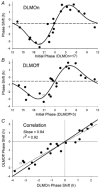A phase response curve to single bright light pulses in human subjects
- PMID: 12717008
- PMCID: PMC2342968
- DOI: 10.1113/jphysiol.2003.040477
A phase response curve to single bright light pulses in human subjects
Abstract
The circadian pacemaker is differentially sensitive to the resetting effects of retinal light exposure, depending upon the circadian phase at which the light exposure occurs. Previously reported human phase response curves (PRCs) to single bright light exposures have employed small sample sizes, and were often based on relatively imprecise estimates of circadian phase and phase resetting. In the present study, 21 healthy, entrained subjects underwent pre- and post-stimulus constant routines (CRs) in dim light (approximately 2-7 lx) with maintained wakefulness in a semi-recumbent posture. The 6.7 h bright light exposure stimulus consisted of alternating 6 min fixed gaze (approximately 10 000 lx) and free gaze (approximately 5000-9000 lx) exposures. Light exposures were scheduled across the circadian cycle in different subjects so as to derive a PRC. Plasma melatonin was used to determine the phase of the onset, offset, and midpoint of the melatonin profiles during the CRs. Phase shifts were calculated as the difference in phase between the pre- and post-stimulus CRs. The resultant PRC of the midpoint of the melatonin rhythm revealed a characteristic type 1 PRC with a significant peak-to-trough amplitude of 5.02 h. Phase delays occurred when the light stimulus was centred prior to the critical phase at the core body temperature minimum, phase advances occurred when the light stimulus was centred after the critical phase, and no phase shift occurred at the critical phase. During the subjective day, no prolonged 'dead zone' of photic insensitivity was apparent. Phase shifts derived using the melatonin onsets showed larger magnitudes than those derived from the melatonin offsets. These data provide a comprehensive characterization of the human PRC under highly controlled laboratory conditions.
Figures




References
-
- Aschoff J, Wever R. The circadian system of man. In: Aschoff J, editor. Biological Rhythms: Handbook of Behavioral Neurobiology. New York: Plenum Press; 1981. pp. 311–331.
-
- Beersma DG, Daan S. Strong or weak phase resetting by light pulses in humans? J Biol Rhythms. 1993;8:340–347. - PubMed
-
- Buresová M, Dvoráková M, Zvolsky P, Illnerová H. Early morning bright light phase advances the human circadian pacemaker within one day. Neurosci Lett. 1991;121:47–50. - PubMed
-
- Cagnacci A, Soldani R, Yen SSC. Contemporaneous melatonin administration modifies the circadian response to nocturnal bright light stimuli. Am J Physiol. 1997;272:R482–486. - PubMed
-
- Czeisler CA. The effect of light on the human circadian pacemaker. In: Waterhouse JM, editor. Circadian Clocks and their Adjustment. Chichester: John Wiley and Sons, Inc.; 1995. pp. 254–302. Ciba Foundation Symposium no. 183.
Publication types
MeSH terms
Substances
Grants and funding
LinkOut - more resources
Full Text Sources
Other Literature Sources
Medical

